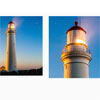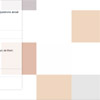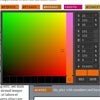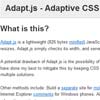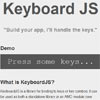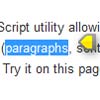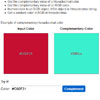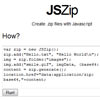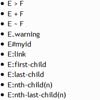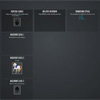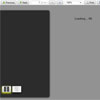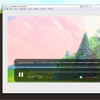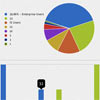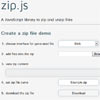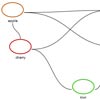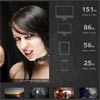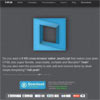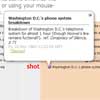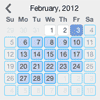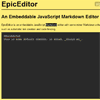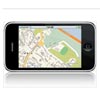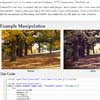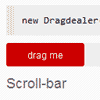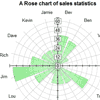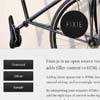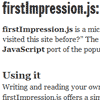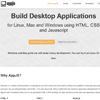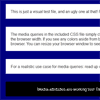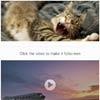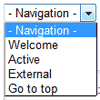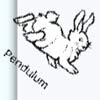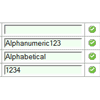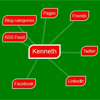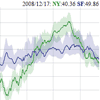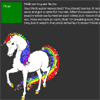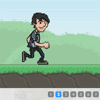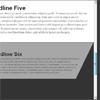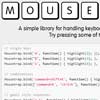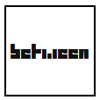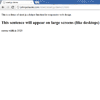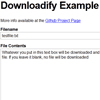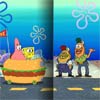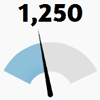Drift 
Easily add "zoom on hover" functionality to your site's images. Lightweight, no-dependency JavaScript.
Installation
- NPM:
npm install drift-zoom - Bower:
bower install drift - Manual: Download and use
dist/Drift.min.jsordist/Drift.js
If you're using the pre-built version of Drift, it will automatically make window.Drift available for your use when included on your page.
If you prefer to use require statements and a build tool like Browserify, here are a couple examples to help:
var Drift = require('drift-zoom'); new Drift(…);If your project uses ES6, you can do the following instead:
import Drift from 'drift-zoom'; new Drift(…);Basic Usage
Once you've installed Drift via one of the above methods, you're ready to get started. There are no dependencies, so you can just start making cool stuff. Check out the announcement blog post for a demo, or take a peek here: https://imgix.github.io/drift. Here's an example of the most basic possible implementation:
<img src="http://assets.imgix.net/dog.png?w=400" data-zoom="http://assets.imgix.net/dog.png?w=1200"> <p>This is a simple description of the dog picture.</p>new Drift(document.querySelector("img"), { paneContainer: document.querySelector("p") });Options / Defaults
Here's an example of using Drift with a custom configuration. All of the listed options are displayed with their default value.
var options = { // Prefix for generated element class names (e.g. `my-ns` will // result in classes such as `my-ns-pane`. Default `drift-` // prefixed classes will always be added as well. namespace: null, // Whether the ZoomPane should show whitespace when near the edges. showWhitespaceAtEdges: false, // Whether the inline ZoomPane should stay inside // the bounds of its image. containInline: false, // How much to offset the ZoomPane from the // interaction point when inline. inlineOffsetX: 0, inlineOffsetY: 0, // A DOM element to append the inline ZoomPane to. inlineContainer: document.body, // Which trigger attribute to pull the ZoomPane image source from. sourceAttribute: 'data-zoom', // How much to magnify the trigger by in the ZoomPane. // (e.g., `zoomFactor: 3` will result in a 900 px wide ZoomPane image // if the trigger is displayed at 300 px wide) zoomFactor: 3, // A DOM element to append the non-inline ZoomPane to. // Required if `inlinePane !== true`. paneContainer: document.body, // When to switch to an inline ZoomPane. This can be a boolean or // an integer. If `true`, the ZoomPane will always be inline, // if `false`, it will switch to inline when `windowWidth <= inlinePane` inlinePane: 375, // If `true`, touch events will trigger the zoom, like mouse events. handleTouch: true, // If present (and a function), this will be called // whenever the ZoomPane is shown. onShow: null, // If present (and a function), this will be called // whenever the ZoomPane is hidden. onHide: null, // Add base styles to the page. See the "Theming" // section of README.md for more information. injectBaseStyles: true, // An optional number that determines how long to wait before // showing the ZoomPane because of a `mouseenter` event. hoverDelay: 0, // An optional number that determines how long to wait before // showing the ZoomPane because of a `touchstart` event. // It's unlikely that you would want to use this option, since // "tap and hold" is much more intentional than a hover event. touchDelay: 0, // If true, a bounding box will show the area currently being previewed // during mouse hover hoverBoundingBox: false, // If true, a bounding box will show the area currently being previewed // during touch events touchBoundingBox: false, // A DOM element to append the bounding box to. boundingBoxContainer = document.body, }; new Drift(document.querySelector('img'), options);API
Drift#disable
Disable your Drift instance. This will prevent your Drift instance from showing, but will not hide it if it's currently visible.
var drift = new Drift(document.querySelector("img"), { paneContainer: document.querySelector("p") }); document.querySelector(".disable-button").addEventListener("click", function() { drift.disable(); });Drift#enable
Enable your Drift instance.
var drift = new Drift(document.querySelector("img"), { paneContainer: document.querySelector("p") }); document.querySelector(".enable-button").addEventListener("click", function() { drift.enable(); });Drift#setZoomImageURL(imageURL)
Change the URL of the zoom image to the passed string. This only has a visible effect while your Drift is currently open. When opening, Drift always pulls the zoom image URL from the specified sourceAttribute. If you want to make a "permanent" change that will persist after the user leaves and re-enters your Drift trigger, you update its sourceAttribute as well (default data-zoom). For more information about this method, please see issue #42.
var triggerEl = document.querySelector("img"); var drift = new Drift(triggerEl, { paneContainer: document.querySelector("p") }); var frames = ["https://mysite.com/frame1.jpg", "https://mysite.com/frame2.jpg", "https://mysite.com/frame3.jpg"]; var currentFrame = 0; setInterval(function() { currentFrame++; if (currentFrame > frames.length - 1) { currentFrame = 0; } drift.setZoomImageURL(frames[currentFrame]); triggerEl.setAttribute("data-zoom", frames[currentFrame]); }, 1200);Theming
By default, Drift injects an extremely basic set of styles into the page. You will almost certainly want to extend these basic styles for a prettier, more usable experience that matches your site. There is an included basic theme that may meet your needs, or at least give a good example of how to build out your own custom styles. The namespace option can be used as a way to easily apply different themes to specific instances of Drift.
If you need to do something very out of the ordinary, or just prefer to include the default styles in CSS yourself, you can pass injectBaseStyles: false when instantiating a new instance of Drift. Please note that if you disable the included base styles, you will still need to provide an animation for .drift-window.drift-opening and .drift-window.drift-closing (this can be a "noop" style animation, as seen in the base styles source).
Browser Support
We support the latest version of Google Chrome (which automatically updates whenever it detects that a new version of the browser is available). We also support the current and previous major releases of desktop Firefox, Internet Explorer, and Safari on a rolling basis. Mobile support is tested on the most recent minor version of the current and previous major release for the default browser on iOS and Android (e.g., iOS 9.2 and 8.4). Each time a new version is released, we begin supporting that version and stop supporting the third most recent version.
Meta
Drift was made by imgix. It's licensed under the BSD 2-Clause license (see the license file for more info). Any contribution is absolutely welcome, but please review the contribution guidelines before getting started.
